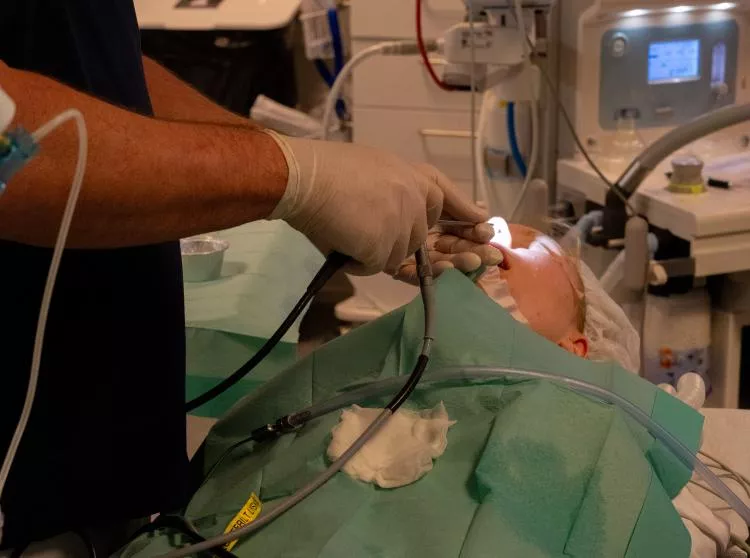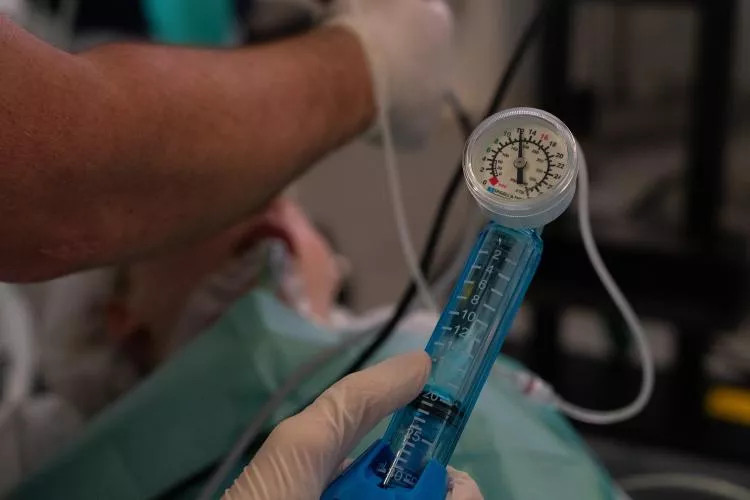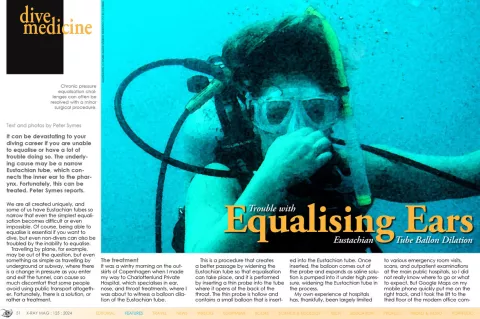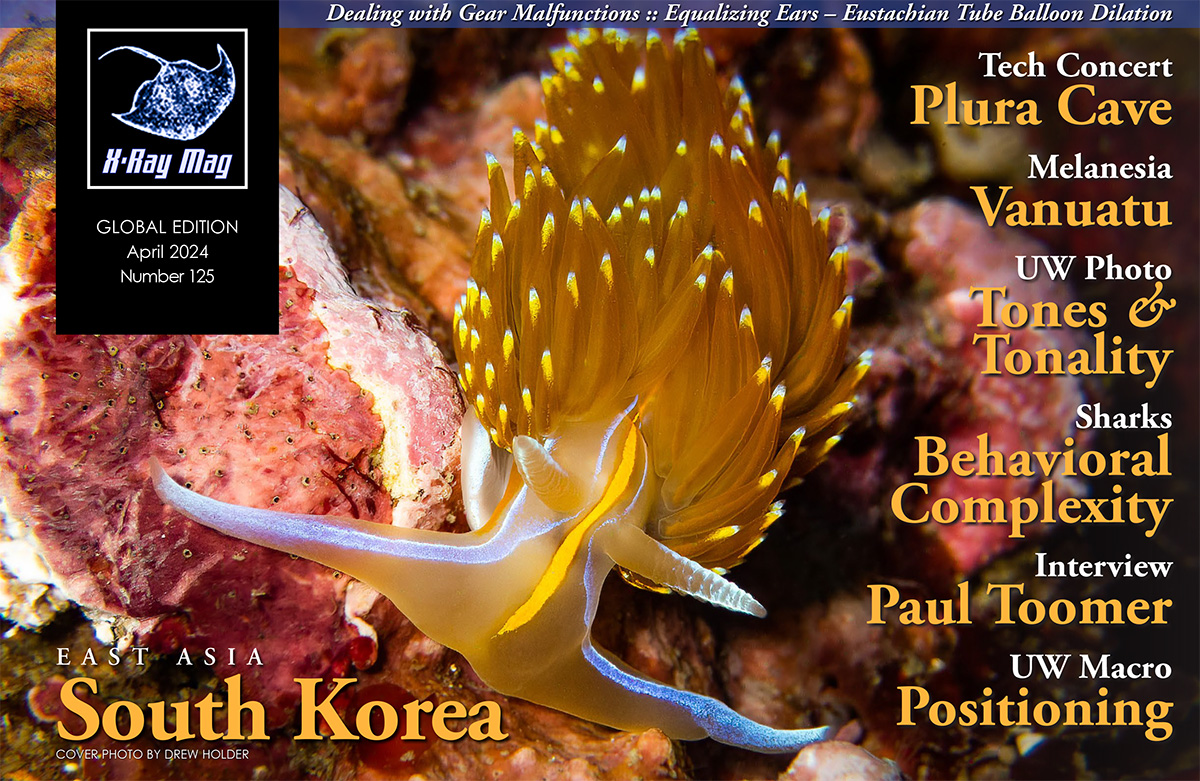It can be devastating to your diving career if you are unable to equalise or have a lot of trouble doing so. The underlying cause may be a narrow Eustachian tube, which connects the middle ear to the pharynx. Fortunately, this can be treated. Peter Symes reports.
Contributed by
We are all created uniquely, and some of us have Eustachian tubes so narrow that even the simplest equalisation becomes difficult or even impossible. Of course, being able to equalise is essential if you want to dive, but even non-divers can also be troubled by the inability to equalise.
Travelling by plane, for example, may be out of the question, but even something as simple as travelling by underground or subway, where there is a change in pressure as you enter and exit the tunnel, can cause so much discomfort that some people avoid using public transport altogether. Fortunately, there is a solution, or rather a treatment.
The treatment
It was a wintry morning on the outskirts of Copenhagen when I made my way to Charlottenlund Private Hospital, which specialises in ear, nose, and throat treatments, where I was about to witness a balloon dilation of the Eustachian tube.
This is a procedure that creates a better passage by widening the Eustachian tube so that equalisation can take place, and it is performed by inserting a thin probe into the tube where it opens at the back of the throat. The thin probe is hollow and contains a small balloon that is inserted into the Eustachian tube. Once inserted, the balloon comes out of the probe and expands as saline solution is pumped into it under high pressure, widening the Eustachian tube in the process.
My own experience at hospitals has, thankfully, been largely limited to various emergency room visits, scans, and outpatient examinations at the main public hospitals, so I did not really know where to go or what to expect. But Google Maps on my mobile phone quickly put me on the right track, and I took the lift to the third floor of the modern office complex, conveniently located close to Charlottenlund train station.
I entered the bright and friendly premises and saw that the waiting room was filled with a mix of patients of different ages, who I assumed were there for an examination, treatment, or follow-up consultation.
I was ushered into the staff lunchroom to wait for the operation I was about to witness. The atmosphere was pleasant, and the staff were friendly and joking with each other, which I took as a good sign.
Today’s patient, Felicia, who was not a diver herself, but who was one of those who experienced discomfort when travelling on public transport, had given me permission to observe her operation. She was now being readied for the operation, while being briefed by the physician and head of the clinic, Dr Jacob Fisker, who is also a dive doctor.
Among other things, he explained that the procedure itself only took about two minutes for each ear, but that it had to be done under general anaesthetic because it would be too uncomfortable and painful for the patient to lie still. It reminded me of the time I had my tonsils removed as a child.
The procedure
The operating theatre was full of technology and equipment. First, an intravenous catheter was inserted into the patient’s hand to administer drugs that make up the initial anaesthetic. Once the patient was unconscious, an endotracheal tube was inserted into the airway to allow the anaesthetist to ventilate the patient, as she would not be able to breathe on her own under general anaesthetic. In this case, a special tube was used that did not block access to the area of the pharynx that needed to be reached. All this took just a few minutes.
The atmosphere was calm and professional as Dr Fisker guided the thin probe through the nasal cavity and found the entrance to the Eustachian tube at the back of the throat. The probe was equipped with a video camera, so I could easily follow the procedure on a large monitor behind the surgical team. Still, I could not quite figure out how he so adeptly manoeuvred the probe behind the right fold in the mucosa and into the tube—but then again, he was the expert, and what did I know?
The balloon was now inside the Eustachian tube and Dr Fisker’s assistant held a small device to increase the pressure in the balloon, which was filled with sterile saline. It was fitted with a small manometer, not unlike the ones we use in diving, so I could watch the gauge reading as the pressure was gradually increased to 10 bar, which forcefully pushed apart the walls of the Eustachian tube and crushed some of the surrounding cartilage.
The balloon was then left in place for a moment while two minutes were counted down, after which it was pulled out again. And that was it for that ear. The procedure was then repeated on the other ear. There was not much to be seen after this, apart from a small amount of blood oozing out. The patient was then brought out of the anaesthetic, pretty much in reverse order. It was not long before she opened her eyes, and I heard a drowsy murmur: “Are we done already?”
Well, yes, that was it—except that Felicia was naturally a bit woozy after the anaesthetic and needed some time to fully recover and get her bearings.
After surgery, patients need to equalise 50 to 100 times a day to keep the passage open. Unlike balloon dilation of coronary arteries and the like, a stent, which is a small hollow spring placed in the artery to keep it dilated, cannot be placed in the Eustachian tube. The patient simply has to keep the passage open and prevent it from collapsing again by performing a Valsalva manoeuvre many times a day. I suppose it quickly becomes a habit that you do not think much about.
I have since heard from Felicia that she has no pain or discomfort and is now just waiting for a check-up in a few months’ time.
Marie’s story
This article came about after I was contacted last year by Marie Carlé, co-owner of the Danish dive travel agency Emocean Travel, who had also undergone a similar operation after suffering various problems with her ears while diving.
She explained that when she was 20 years old, she travelled to Thailand, where she intended to get certified, but had to give it up and go snorkelling instead because she was just unable to equalise. Fifteen years later, however, she did manage to complete a PADI Open Water Diver course, but not without many trials and considerable pain.
Marie wrote: “For the next two years I dived a lot. I travelled to South Africa, the Philippines, the United States, Bali, and countless times to the Red Sea to dive. I racked up 200 dives pretty quickly, but it was always with me. Initially, I swam above everyone else at 2 to 3 metres of depth for the first 10 to 15 minutes of the dive, after which I slowly got down to 10 metres, where the pain disappeared. I came up with various little tricks, such as sucking the condensation out of my regulator and swallowing it while moving my jaw back and forth.”
Marie had tried everything and had been to many ear specialists who told her she just needed to practise equalisation. She also tried Otrivin, steroid sprays and more. But none of it helped. Then she met Dr Fisker in an unrelated matter regarding her children’s ear problems and learnt about balloon dilation, which she had never heard of.
After a similar operation, Marie was suddenly able to equalise, but then had to undergo another balloon dilation on her left ear afterwards. Marie said she has since done hundreds of dives without any equalisation issues. “I have done another 400 dives on group trips and go down to 10 metres faster than any of the others! I barely move my jaw for my ears to pop just fine. And best of all, I am pain free!”
Another problem solved
Marie did not get off so lightly, however, as some time later her left eardrum burst at a depth of three metres during a liveaboard trip in the Red Sea.
Marie’s eardrum had become very thin, probably due to a lot of middle ear infections as a child, combined with many subsequent strains caused by equalisation problems over the years. But there was a solution for that, too. Marie simply had her eardrum repaired by transplanting a piece of cartilage from her ears and within six weeks of surgery she was able to dive again.
The fact that Marie had multiple problems with her ears is quite unusual and it should be emphasised that the two cases or problems have nothing to do with each other. However, her story illustrates that there are several different treatments available to help divers with ear problems, even if you think there is nothing that can be done and you fear that your diving career is over.
The lesson to be learnt from these stories, however, is that you can dive again, even if you have struggled with these chronic problems or have had an accident. You just need to know that treatment is available and where to go to get it. ■


































